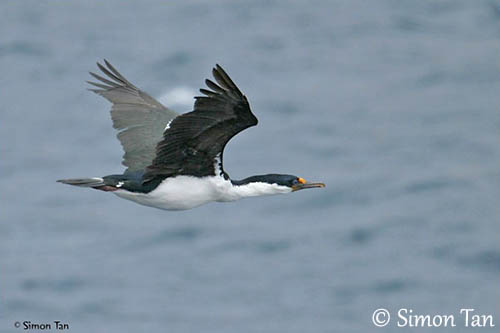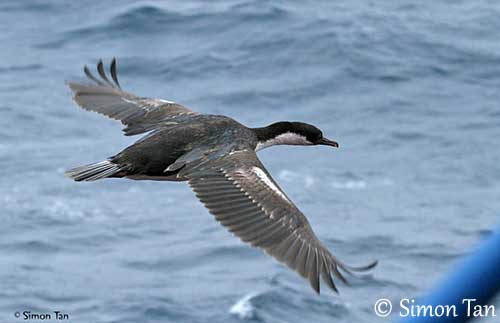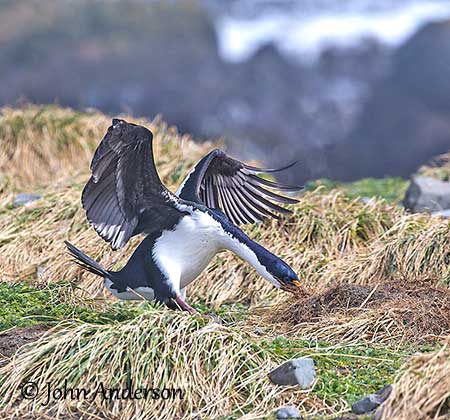
Fr: Cormoran de Macquarie
All: Macquariescharbe
Esp: Cormorán de la Macquarie
Ita: Cormorano delle Macquarie
Nd: Macquarieaalscholver
Sd: Macquarieskarv
Photographer:
John Anderson
John Anderson Photo Galleries
Simon Tan
PBase Bird galleries
Text by Nicole Bouglouan
Sources:
HANDBOOK OF THE BIRDS OF THE WORLD vol 1 by Josep del Hoyo-Andrew Elliot-Jordi Sargatal - Lynx Edicions - ISBN: 8487334105
Department of Sustainability, Environment, Water, Population and Communities
Australian Antarctic Division: Leading Australia's Antarctic Program
Wikipedia, the free encyclopaedia
Macquarie Shag
Leucocarbo purpurascens
Suliformes Order – Phalacrocoracidae Family
INTRODUCTION:
The Macquarie Shag is sometimes considered a subspecies of the Imperial Shag (Leucocarbo atriceps), but it is currently considered a full species. It is very similar to other blue-eyed cormorants living throughout the Sub Antarctic islands, but they have well separated ranges.
DESCRIPTION OF THE BIRD:
Biometrics:
Length: 71-75 cm
Wingspan: 110 cm
Weight: 2500-3500 g
The adult has black hindneck and upperparts with blue gloss. Scapulars and upperwing show more bronzy gloss. A white wingbar is formed by several lesser upperwing secondary coverts. Flight feathers and greater coverts have brownish-silver sheen. The tail is duller and blackish, with whitish shafts at base. It may have some hair-like white filoplumes on head and upperparts.
The underparts are white with blackish underwing, although the basal part of the leading edge is white. The outer side of the thighs is black.
The head is black with greenish-blue gloss down to gape. Chin, throat and foreneck are white.
During the breeding season, there is a black crest on the forecrown, which is much reduced or lost towards the end of this period. The white filoplumes are lost too, and the plumage becomes duller.
The eyes are dark greenish-brown, surrounded by blue, bare eyering. We can see conspicuous yellow caruncles on sides of forehead, and smaller darker yellow caruncles on the blackish background around the gape, at base of lower mandible.
The bill is blackish with horn-coloured tip. Legs and webbed feet are pink.
Outside the breeding season, the caruncles are duller and reduced. The eyering is dull bluish. The bill becomes brownish with pale tip. Legs and feet show dull brownish on rear of tarsus, joints and webs.

Both sexes are similar.
The juvenile lacks crest and caruncles. The eyering is dull bluish-grey. Legs and feet are dull pinkish-brown. The plumage is duller than in adults, with dull dark brown upperparts with faint green seen.
RANGE:
The Macquarie Shag is endemic to Macquarie Island, and also occurs on the nearby Bishop and Clark islets, S of New Zealand.
HABITAT:
The Macquarie Shag forages in the inshore waters of Macquarie Island, and remains near the shore, where the sea-bottom is not too deep.
It breeds on bare rocky shores and stacks attached to the shore, and also among boulders on the shoreline.
CALLS AND SONGS:
The Macquarie Shag is usually noisy at colonies. The advertising call by male is a barking “ee-oh” or “heh-heh”. It produces growls and rough “harr” in threat display. The gaping display is accompanied by slow “heh heh heh” and others by loud, repeated “orgh”. The female gives mostly hissing calls.
BEHAVIOUR IN THE WILD:
The Macquarie Shag feeds primarily on fish, but it also takes crustaceans and marine invertebrates. It takes benthic fish and invertebrates of several species.
It forages in shallow water, often under rocks or among kelp beds. Like other cormorants, it hunts by pursuit-diving, as deep as 50 metres.
Outside the breeding season, they feed in flocks of up to 40 birds, but during the reproduction, they are solitary hunters.

REPRODUCTION OF THIS SPECIES:
The laying occurs mainly in October/November. The colonies are sometimes alongside penguins.
The nest is a truncated cone made with tussock grass held together with mud and excreta. It is placed on the ground, among boulders and near the high-tide line. There is a strong competition for nest-sites, and males defend them actively. The nests are 1-2 metres apart.
The female lays 1-3 blue-green eggs. Both adults incubate during about one month (32-33 days). At hatching, the chicks are naked, but they are quickly covered with brown down. They hatch in December, and fledge between late January and mid-February. They become quickly independent. They are sexually mature at 2-4 years old.
PROTECTION / THREATS / STATUS:
The Macquarie Shag is a rare bird. The main causes of mortality are first, the predation by Brown Skua, the subspecies Stercorarius antarcticus lonnbergi, and then, the effect of adverse weather involving nest destruction and restricted access to preys. The storms may also destroy colonies and adults.
The Macquarie Shag is currently listed as Vulnerable, with small population (less than 1000 mature individuals) and restricted range.
At the beginning of the breeding season, it performs spectacular courtship displays with bowing and dances, and elaborate postural displays to attract a female. These displays are performed during the pair-bonding, but also during the changeover at nest during the incubation.
The Macquarie Shag breeds in colonies of 3 to 300 nests, and the nest-building starts in July. Since 2011, feral cats and rats have been eradicated from Macquarie Island. They were the main predators of chicks and eggs.
The Macquarie Shag is sedentary and travels only between E and W coasts by flying along the coast, not over land.
Outside the breeding season, they roost in flocks on the bare ground.
This species has small wings and only performs very local movements.
